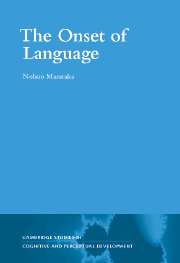Book contents
- Frontmatter
- Contents
- List of figures
- List of tables
- Acknowledgements
- 1 Introduction
- 2 The development of the ability to take turns
- 3 Cooing in three-month-old infants
- 4 The development of vocal imitation
- 5 How infant-directed speech influences infant vocal development
- 6 From laughter to babbling
- 7 Earliest language development in sign language
- 8 From babbling to speaking
- 9 Summary and conclusion
- References
- Index
6 - From laughter to babbling
Published online by Cambridge University Press: 15 January 2010
- Frontmatter
- Contents
- List of figures
- List of tables
- Acknowledgements
- 1 Introduction
- 2 The development of the ability to take turns
- 3 Cooing in three-month-old infants
- 4 The development of vocal imitation
- 5 How infant-directed speech influences infant vocal development
- 6 From laughter to babbling
- 7 Earliest language development in sign language
- 8 From babbling to speaking
- 9 Summary and conclusion
- References
- Index
Summary
A major milestone in the vocal development of preverbal hearing infants is the emergence of reduplicated consonant-vowel sequences such as da da da. In these series, the consonant initially remains the same. This is known as reduplicated babbling but it is more frequently referred to simply as babbling. Although infants might babble in the communicative context of infant–caregiver interaction, no meaning or reference can be assigned to the babble itself. Babbling must also be word-like. It is thought that babbling is characterized by the use of a subset of all possible sounds and syllable organizations found in spoken languages. As a consequence, the regular emergence of babbling has been interpreted as evidence of a biological preparedness for speech. According to Lenneberg (1967), babbling is a phenomenon of speech development that does not depend on the availability of input and all children begin babbling between the ages of six and eight months, whether or not they are hearing or deaf. While such traditional perspectives regarded babbling as a true precursor to speech, other infant vocalizations were regarded as random collections of miscellaneous sounds unrelated to the later emergence of true speech. More recent research, however, does not support this view. For example, with respect to rhythmic vocal production, there is continuity between babbling and earlier vocalizations. Prior to the onset of true babbling, infants come to utter sequences of vowel-like sounds without distinctive consonant-like elements.
- Type
- Chapter
- Information
- The Onset of Language , pp. 157 - 187Publisher: Cambridge University PressPrint publication year: 2003

